| Here Is Good News on Black Student College Graduation Rates But a Huge Racial Gap Persists Nationwide, the black student college graduation rate remains at a dismally low 44 percent. But the college completion rate has improved by five percentage points over the past four years. As ever, the overall black-white gap in college graduation rates remains very large at 19 percentage points. But there is improvement in black student college completion rates at many of the nation’s highest-ranked colleges and universities, at state-operated flagship universities, and at a large number of historically black colleges and universities. Throughout the nation, African-American enrollments in higher education have reached an all-time high. Combining both bachelor’s and graduate degree programs and enrollments in two-year community colleges, there are now more than 2 million African Americans enrolled in higher education in the United States. But a more important statistical measure of the performance of blacks in higher education is not simply the number of black students entering college but how many are actually earning a college degree. The economic gains that come from a four-year college degree are transparently obvious. Census Bureau data shows that, as expected, black students who earn a four-year college degree have incomes that are substantially higher than blacks who have only some college experience but have not earned a degree. Most important is the fact that blacks who complete a four-year college education have a median income that is now near parity with similarly educated whites. But the good news is severely tempered by the unacceptably low college completion rates for black students. According to the most recent statistics, the nationwide college graduation rate for black students stands at an appallingly low rate of 44 percent.* This figure is 19 percentage points below the 63 percentage rate for white students. As a result of the racial graduation rate gap, only 19 percent of young black adults hold a four-year college degree compared to 34 percent of young white adults. However, there is positive news. Over the past four years, the black student graduation rate has improved by five percentage points. *Student graduation rates are calculated by comparing the number of entering freshmen in a given year to those who receive their diploma at the same institution within a six-year period. The most recent data is for students who entered college in the fall of 2000 and who received their diploma by June 2006. To eliminate one-year statistical aberrations, the figures used throughout this article are four-year averages and include data for students who entered college from 1997 to 2000 and earned their diploma within six years.
Black Women Outpace Black Men in College Completions
Long-term, over the past 17 years, black men have improved their graduation rate from 28 percent to 37 percent. This year the college graduation rate for black women rose by one percentage point to 48 percent. And over the past 17 years, the graduation rates for black women have shown strong and steady gains. Turning in a powerful performance over the past 17 years, black women have improved their college completion rate from 34 percent in 1990 to 48 percent in 2007. So for black women, we appear to be very close to the point where one half of all black women students who enter a particular college will go on to earn their degree from that same institution. Since 1990 black women have increased their four-year college graduation rate by 14 percentage points. For black men, there was a nine percentage point gain during the 17-year period.
Colleges and Universities With the Highest Black Student Graduation Rates
For many years Harvard University, traditionally one of the nation’s strongest and most dedicated supporters of affirmative action, has produced the highest black student graduation rate of any college or university in the nation. The 2007 data shows Harvard’s black student graduation rate is 96 percent, again the highest among U.S. colleges and universities. The black student graduation rate at Harvard increased by one percentage point this year. Yale University and Wellesley College both show a black student graduation rate of 94 percent. Yale improved its black graduation rate by two percentage points this year. Princeton University and the California Institute of Technology both posted black student graduation rates of 93 percent. Over the four-year period from 1997 to 2000, only 14 black first-year students enrolled at CalTech and 13 went on to earn their diplomas. The figures demonstrate the tyranny of small numbers. If only one additional black student did not complete his degree program, the black student graduation rate would have dropped to under 86 percent. Amherst College, the small, highly selective liberal arts college in western Massachusetts, now has a black student graduation rate of 92 percent. This is down two percentage points from a year ago. Williams College, Brown University, Stanford University, and Washington University in St. Louis all posted a black student graduation rate of 90 percent. Overall there are 10 high-ranking colleges and universities with a black student graduation rate of at least 90 percent. Seventeen other high-ranking institutions have a black student graduation rate of 86 percent or above. They are Swarthmore College, Dartmouth College, Lafayette College, Northwestern University, the University of Pennsylvania, Vanderbilt University, Wake Forest University, and Smith College. Also posting black student graduation rates of at least 86 percent are Pomona College, the University of Virginia, Wesleyan University, Columbia University, Duke University, George-town University, Johns Hopkins University, Rice University, and the University of Notre Dame. All told there are 27 colleges and universities with a black student graduation rate of at least 86 percent. This is considerable progress. A year ago there were 21 colleges and universities with a black student graduation rate of 86 percent or above.
High-Ranking Institutions Reporting Low Black Student Graduation Rates
Other high-ranking colleges and universities showing black student graduation rates below 75 percent are Middlebury College, Carleton College, Washington and Lee University, Bates College, UCLA, the University of California at Berkeley, Carnegie Mellon University, and the University of North Carolina at Chapel Hill.
Explaining the Differences in Black Student Graduation Rates Why are black graduation rates very strong at some high-ranking institutions and considerably weaker at other top-ranked schools? Here are a few possible explanations: • Clearly, the racial climate at some colleges and universities is more favorable toward African Americans than at other campuses. A nurturing environment for black students is almost certain to have a positive impact on black student retention and graduation rates. Although often troubled by racial incidents, Brown University is famous for its efforts to make its campus a happy place for African Americans. In contrast, the University of California at Berkeley has had its share of racial turmoil in recent years. The small number of black students on campus as a result of the abolition of race-sensitive admissions has caused many African Americans on campus to feel unwelcome. This probably contributes to the low black student graduation rate at Berkeley. • Many of the colleges and universities with high black student graduation rates have set in place orientation and retention programs to help black students adapt to the culture of predominantly white campuses. Mentoring programs for black first-year students involving upperclassmen have been successful at many colleges and universities. Other institutions appear to improve graduation rates through strong black student organizations that foster a sense of belonging among the African-American student population. The presence or absence of these programs may have some impact on graduation rates. • Geographic location unquestionably plays a major role in black student graduation rates. For example, Bates College in Maine is located in a rural area with a very small to negligible black population. The same holds true for Grinnell College in Iowa, Oberlin College in Ohio, and Carleton College in Minnesota. Black student graduation rates at many of these rural schools are lower than at colleges and universities in urban areas. • The presence of a strong and relatively large core of black students on campus is important. Among the highest-ranked colleges and universities, institutions that tend to have a low percentage of blacks in their student bodies, such as CalTech, Bates, Middlebury, Grinnell, Davidson, Carleton, and Colby, also tend to have lower black student graduation rates. Black students who attend these schools may have problems adjusting to college life in an overwhelmingly white environment. And these schools are less likely to have a large number of black-oriented social or cultural events to make black students feel at home. • Curriculum differences also play an important role in graduation rates. Carnegie Mellon University and MIT are heavily oriented toward the sciences, fields in which blacks have always had a small presence. It continues to be true that at many high-powered schools black students in the sciences often have been made to feel uncomfortable by white faculty and administrators who persist in beliefs that blacks do not have the intellectual capacity to succeed in these disciplines. • High dropout rates appear to be primarily caused by inferior K-12 preparation and an absence of a family college tradition, conditions that apply to a very large percentage of today’s college-bound African Americans. But equally important considerations are family wealth and the availability of financial aid. According to a study by Nellie Mae, the largest nonprofit provider of federal and private education loan funds in this country, 69 percent of African Americans who enrolled in college but did not finish said that they left college because of high student loan debt as opposed to 43 percent of white students who cited the same reason. Under any circumstance, a college education requires huge amounts of money. Not only are there very large outlays for tuition, books, and travel, but, even more important, going to college takes a student out of the work force for four or more years. The total bite into family income and wealth can amount to $160,000 or more per student. High and always increasing college costs tend to produce much greater hardships for black families. Deep financial pockets enable some schools to provide greater financial aid than others. And this is a major factor in student graduation rates. Well-funded universities such as Princeton, which has the nation’s largest endowment per student and one of the nation’s most generous financial aid program for low-income students, will undoubtedly claim an advantage in black student retention and, subsequently, in producing high graduation rates. Clearly, the availability of a high level of financial aid shields low-income black students from financial pressures that may force minority students to leave college to fulfill family obligations and financial responsibilities. This journal has always placed a heavy emphasis on financial pressures as a major agent in producing low black graduation rates. But, undoubtedly, cultural and family issues bear a huge responsibility. Invariably, the critical problem is that a very high number of young blacks are entering college with wholly inadequate academic credentials, ambition, and study habits. We accept the view that a strong black student graduation rate is a good indicator of institutional success in racial integration of a given campus. But readers are cautioned that a lower graduation rate also can be a positive indicator of a college or university’s willingness to take a chance on academically dedicated young black students with substandard academic credentials.
Comparing Black and White Graduation Rates at High-Ranking Colleges and Universities A strong case can be made that a better way of comparing the performance of the nation’s highest-ranked colleges and universities in successfully graduating black students is to examine the difference in the graduation rates between their black and white students. Using this comparison, a high-ranking institution such as Claremont McKenna College in California, which has a black student graduation rate of 85 percent — a figure below many of its peer institutions — nevertheless ranks high on a relative basis because its white student graduation rate of 83 percent is two percentage points lower than the rate for black students. Many academics and administrators will be surprised to hear that there are in fact a few selective colleges in the United States that report a higher graduation rate for blacks than for whites. Six of the nation’s highest-ranked colleges and universities actually have a higher graduation rate for black students than for white students. According to the latest statistics from Mount Holyoke College, Pomona College, Smith College, Wellesley College, Wake Forest University, and the California Institute of Technology, a black student on these campuses is more likely to complete the four-year course of study and receive a diploma than is a white student. JBHE has not been able to identify the reason for the anomaly that occurs at these five institutions, which is markedly inconsistent with nationwide statistics. But it is interesting to note that three of the six institutions are women’s colleges. Also encouraging is the fact that the black student graduation rate is identical to the rate for white students at Vanderbilt University in Nashville, Tennessee. This is good news because Vanderbilt has been able to reach racial parity in student graduation rates during a period in which it has greatly increased black enrollments. At some other high-ranking educational institutions, the difference in black and white graduation rates is very small. Washington University in St. Louis has a 90 percent graduation rate for black students, just one percentage point below its rate for whites. At Lafayette College in Easton, Pennsylvania, the white student graduation rate is only one percentage point higher than the rate for blacks, which stands at 88 percent. At Harvard University, Claremont McKenna College, and Macalester College, the racial difference is only two percentage points. At the Ivy League schools Harvard, Princeton, Columbia, and Yale, the black graduation rates are relatively high, and in all instances they are five percentage points or less below the graduation rate for white students. At Penn, Dartmouth, Brown, and Cornell, there is at least a six percentage point racial gap in graduation rates. All told, there are 38 high-ranking colleges and universities that have a favorable black-white graduation rate difference of eight percentage points or less. Six years ago only 16 high-ranking colleges and universities had a graduation rate gap of eight percentage points or less. This is a strong sign of progress. But all the news is not good. Overall, 16 of the 53 colleges in our survey still report a black graduation rate that is 10 percentage points or more below the graduation rate for white students. Last year there were three high-ranking schools with at least a 20 percentage point gap. They were Middlebury College, the University of Michigan, and Carleton College. Carleton and Michigan showed improvement this year. Middlebury is the only high-ranking college this year where the black student graduation rate is more than 20 percentage points higher than the rate for whites.
Trends in Black Student Graduation Rates at Highly Ranked Universities
The greatest improvement in the black student college graduation rate occurred at the California Institute of Technology. The black student completion rate at CalTech has improved from 60 percent to 93 percent. But there are so few black students at CalTech, usually one or two in each class, that the graduation rate figure can fluctuate to a large degree based on the performance of just one or two students. Far more impressive is the 25 percentage point increase in the black student graduation rate at Carnegie Mellon University. There, the four-year average black graduation rate rose from 47 percent in 1998 to 72 percent in 2007. There was a five percentage point gain at Carnegie Mellon this year alone. Similarly impressive gains in black student graduation rates occurred at the University of Pennsylvania, Rice University, UCLA, Columbia University, and Vanderbilt University. Each university has seen its black student graduation rate improve by at least 13 percentage points over the 1998 to 2007 period. Columbia University, which showed an 8 percentage point drop in black student graduation rates from 1993 to 1999, has shown a rebound over the past eight years. Since 1999 the black student graduation rate at Columbia rose from 72 percent to 86 percent. There has been a major improvement in the African-American student graduation rate at the University of California at Berkeley over the past decade. Since 1993 the black student graduation rate at Berkeley has increased from 51 percent to 73 percent. A large part of this increase occurred in the 1993 to 1998 period. It is important to recall that the dramatic rise in black student graduation rates at Berkeley occurred during a period in which the university was still pursuing a strong affirmative action admissions program. These figures suggest that, contrary to the view expressed by most racial conservatives, there was a strong improvement in black graduation rates during the recent period of intense affirmative action in admissions at Berkeley. This tends to confirm that preferential admissions are not a big drag on black student college graduation rates.
Many of the nation’s highest-ranked liberal arts colleges only have been reporting graduation rates by race for the past several years. In 2007, 15 of the 22 high-ranked liberal arts colleges in our survey showed an improvement in black student graduation rates from their 1998 rates. At Oberlin College in Ohio, there was a huge 23 percentage point improvement in the decade from 56 percent to 79 percent. At Macalester College in Minnesota, there was a 20 percentage point gain since 1998. At Wellesley, Davidson, Trinity, and Smith, the black student graduation rate improved by 11 percentage points or more over the past eight years. Six highly ranked liberal arts colleges saw a decline in their black student graduation rate over the past decade. The largest drop was at Haverford College in Pennsylvania. In 1998 the school posted a black graduation rate of 93 percent. This year the African-American student graduation rate stands at 84 percent. But it is important to note that the black student graduation rate at Haverford rose by three percentage points over the past year.
Comparing the Graduation Rates at Flagship State Universities
But this measure does not always present an accurate assessment of black students’ success in graduating from a college in a given state. At some state-chartered universities such as the University of North Carolina, the University of Virginia, the University of Maryland, and the University of Michigan, concerted efforts are in place to attract high-achieving black students from other states. For example, the University of Wisconsin has a program to recruit high-performing black students from Chicago’s public school system. An influx of talented black students at selective flagship universities from out of state tends to inflate the overall black student graduation rate at these universities. With this caveat, our calculations show that by a large margin the University of Virginia has the highest black student graduation rate of any state-chartered institution in the nation. The black graduation rate at the university is 87 percent. The next-highest black student college completion rate at a flagship state university is at the University of North Carolina at Chapel Hill. There, and at the University of California at Berkeley, the black student graduation rate is 73 percent. The University of Michigan has a black student graduation rate of 70 percent.
Six states and the District of Columbia have flagship state-chartered universities at which the African-American student graduation rate is 34 percent or below. In addition to the University of the District of Columbia, the states that have flagship universities with a black student graduation rate below 34 percent are Alaska, South Dakota, North Dakota, New Mexico, Montana, and Nevada.
Long-Term Progress in Black Student Graduation Rates at Flagship State Universities Among the best news reported here is that blacks are making tremendous progress in improving their graduation rates at flagship state universities, which, combined, educate tens of thousands of black students. Among 25 flagship universities with large numbers of black students, the graduation rate has improved at 24 institutions since 1998. The only exception is the University of Virginia, which maintained its leading 87 percent black student graduation rate over the period. Some of the black graduation gains have been spectacular. For example, the black student graduation rate at both the University of Florida and the University of Texas has increased by more than 20 percentage points since 1998. At the University of Georgia, the University of Connecticut, and the University of Maryland, the black student graduation rate has improved by more than 15 percentage points.
Graduation Rates at Historically Black Colleges and Universities
By a large margin, the highest black student graduation rate at a historically black college belongs to Spelman College, the academically selective, all-women’s school in the city of At-lanta. In fact, Spelman’s black student graduation rate of 78 percent is higher than the black student graduation rate at 12 of the nation’s 53 high-ranking predominantly white colleges and universities referred to earlier. Spelman’s unusual strength shows in the fact that it has a higher black student graduation rate than do such prestigious and primarily white colleges as Bates, Colby, Berkeley, UCLA, Michigan, Bowdoin, Chapel Hill, and Carnegie Mellon. Following Spelman in the rankings, the next-highest black student graduation rate among the HBCUs was at Fisk University. At Fisk, 64 percent of the entering black students go on to graduate within six years. Claflin University in South Carolina has a black student graduation rate of 62 percent. Hampton University, Miles College, Howard University, and Morehouse College, sadly, are the only other HBCUs that graduate at least half of their black students within six years. Here is the worst news of all: At 24 HBCUs two thirds or more of all entering black students do not go on to earn a diploma. The lowest graduation rate was at the University of the District of Columbia, where only 12 percent of entering freshmen go on to earn a bachelor’s degree. The good news here is that in 2007 the graduation rate at the University of the District of Columbia was only 8 percent. At Texas Southern University in Houston and LeMoyne-Owen College in Tennessee, 14 percent of entering students complete college. The low graduation rates at black colleges are due to a number of reasons. Many of the students enrolled at these institutions are from low-income families, often ones in which there are few books in the home and where neither parent nor grandparent went to college. In addition, as stated above, the black colleges on the whole have very small and totally inadequate endowments and lack the necessary resources to generate funds for student financial aid. Often they are unable to furnish sufficient aid packages for upperclassmen to permit them to stay in school. But another important explanation for the high dropout rate at the black colleges is the fact that large numbers of African-American HBCU students do not come to college with strong academic preparation and study habits. The graduation results at the HBCUs are worsened by the fact that flagship universities in the southern states often tend to shuttle the lowest-performing black applicants into the state-controlled black colleges in their states. JBHE has collected student graduation rate statistics going back to 1998 for a group of 36 historically black universities. The good news is that during this period 18 of the 36 colleges and universities have seen an improvement in their black student graduation rates. Fifteen black colleges and universities showed a decline in their black graduation rate. The college completion rate at Coppin State University, South Carolina State University, and Southern University in Baton Rouge remain unchanged. Over the past decade there have been huge differences in graduation rates at some of these HBCUs. For example, the black graduation rate at Fisk University increased from 46 percent in 1998 to 64 percent today. In 1993 the black student graduation rate at Fisk was only 25 percent. Other schools showing large improvements in their black student graduation rates are Lincoln University in Missouri, Tennessee State University, Alcorn State University, and Howard University. All of these black colleges and universities have seen a 12 percentage point or more rise in black student graduation rates over the past eight years. At the University of Maryland Eastern Shore and Prairie View A&M University in Texas, the black student graduation rate has improved by 10 percentage points over the past eight years. In contrast, the black graduation rate at Shaw University in North Carolina shows a 12 percentage point drop in black student graduation rates over the past decade. At Lincoln University of Pennsylvania, Rust College, and Florida A&M University, there was a nine percentage point drop during the period. There was also at least a five percentage point decline in the African-American student graduation rate at Livingstone College and Fayetteville State University.
|
|




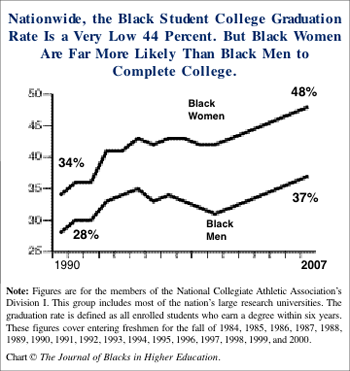 In each of the three years before the turn of the century, from 1998 through 2000, there was an annual one percentage point decline in the overall graduation rate of black men. But for the past six years the graduation rate for black men has improved marginally by one percentage point and now stands at a still very low 37 percent.
In each of the three years before the turn of the century, from 1998 through 2000, there was an annual one percentage point decline in the overall graduation rate of black men. But for the past six years the graduation rate for black men has improved marginally by one percentage point and now stands at a still very low 37 percent. 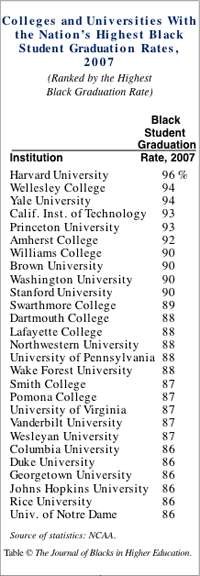 Invariably, the black student graduation rate for men and women is significantly higher at the nation’s selective colleges and universities. This is to be expected since these students enter college with much stronger academic credentials than is the case for less selective schools.
Invariably, the black student graduation rate for men and women is significantly higher at the nation’s selective colleges and universities. This is to be expected since these students enter college with much stronger academic credentials than is the case for less selective schools.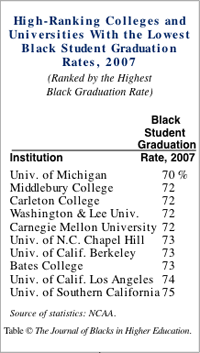 For the first time since JBHE has been collecting data on black student graduation rates a decade ago, all of the nation’s highest-ranked colleges and universities have a black student graduation rate of at least 70 percent. Among the nation’s colleges and universities that are commonly rated as selective, the lowest black student graduation rate occurs at the University of Michigan. Currently only 70 percent of the black freshmen who enroll at the University of Michigan go on to graduate. There are now 334 black freshman students at the University of Michigan. If these black students graduate at the same rate as have their peers in the recent past, about 100 of them will fail to earn their bachelor’s degree.
For the first time since JBHE has been collecting data on black student graduation rates a decade ago, all of the nation’s highest-ranked colleges and universities have a black student graduation rate of at least 70 percent. Among the nation’s colleges and universities that are commonly rated as selective, the lowest black student graduation rate occurs at the University of Michigan. Currently only 70 percent of the black freshmen who enroll at the University of Michigan go on to graduate. There are now 334 black freshman students at the University of Michigan. If these black students graduate at the same rate as have their peers in the recent past, about 100 of them will fail to earn their bachelor’s degree.
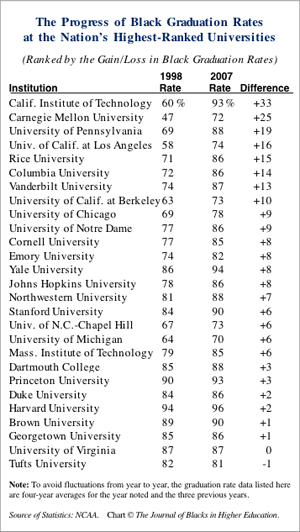 So far we have reported the latest available data on the current graduation rates of black students at the nation’s most prestigious colleges. We now examine the long-term trend in black graduation rates at these universities over the past decade. Of the 27 high-ranked universities for which JBHE has long-term college completion data, the black graduation rate has improved at 25 institutions. This is very good news.
So far we have reported the latest available data on the current graduation rates of black students at the nation’s most prestigious colleges. We now examine the long-term trend in black graduation rates at these universities over the past decade. Of the 27 high-ranked universities for which JBHE has long-term college completion data, the black graduation rate has improved at 25 institutions. This is very good news.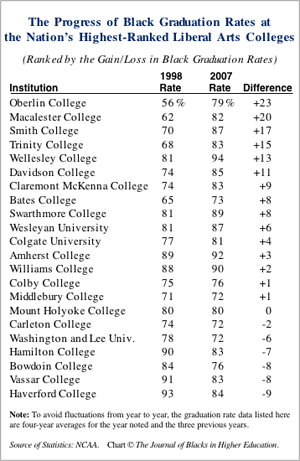 The Trend in Black Student Graduation Rates at High-Ranking Liberal Arts Colleges
The Trend in Black Student Graduation Rates at High-Ranking Liberal Arts Colleges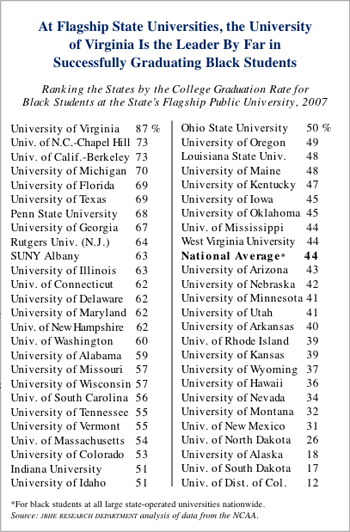 An important aspect of our report are graduation rates at the nation’s so-called flagship state universities. Always keep in mind that America’s large state universities educate three fourths of all African-American college students in the United States. In preparing this ranking we are necessarily gauging in effect the success of the particular state in graduating large numbers of black students who for the most part live within the state. And this measure gives us a good indicator of the graduation rate for the “average” black student in the state.
An important aspect of our report are graduation rates at the nation’s so-called flagship state universities. Always keep in mind that America’s large state universities educate three fourths of all African-American college students in the United States. In preparing this ranking we are necessarily gauging in effect the success of the particular state in graduating large numbers of black students who for the most part live within the state. And this measure gives us a good indicator of the graduation rate for the “average” black student in the state. 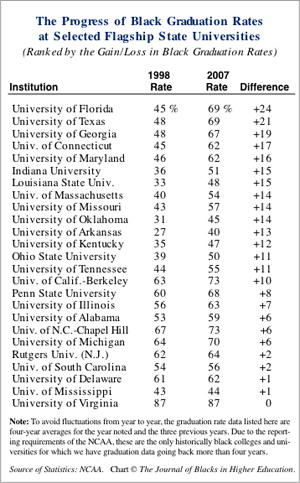 Twelve other states have flagship universities that post a black student graduation rate of 60 percent or higher. These are the state universities in Pennsylvania, Delaware, New Hampshire, Maryland, Florida, New York, Connecticut, Georgia, Texas, Illinois, Washington, and New Jersey.
Twelve other states have flagship universities that post a black student graduation rate of 60 percent or higher. These are the state universities in Pennsylvania, Delaware, New Hampshire, Maryland, Florida, New York, Connecticut, Georgia, Texas, Illinois, Washington, and New Jersey.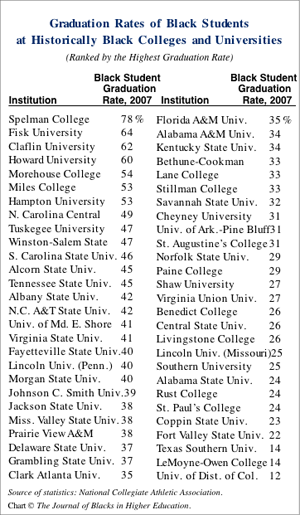 As expected, the graduation rate of African-American students at the nation’s historically black colleges and universities (HBCUs) tends to be much lower than the graduation rate for black students at the nation’s highest-ranked institutions. Many of the private black colleges have puny endowments and therefore are not able to offer generous financial aid packages. However, the graduation rate at a significant number of HBCUs is well above the nationwide average for black student graduations, which, as stated earlier, currently stands at an extremely low rate of 44 percent. And many black colleges have shown considerable improvement in recent years in their black student graduation rates.
As expected, the graduation rate of African-American students at the nation’s historically black colleges and universities (HBCUs) tends to be much lower than the graduation rate for black students at the nation’s highest-ranked institutions. Many of the private black colleges have puny endowments and therefore are not able to offer generous financial aid packages. However, the graduation rate at a significant number of HBCUs is well above the nationwide average for black student graduations, which, as stated earlier, currently stands at an extremely low rate of 44 percent. And many black colleges have shown considerable improvement in recent years in their black student graduation rates.